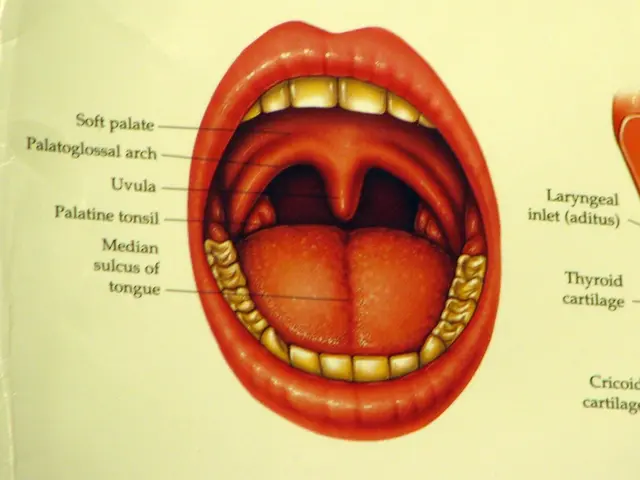Connection Between Breast and Ovarian Cancer: Identified Links and Risk Factors
Here's a revised version of the provided article, incorporating the enrichment data where it fits naturally and restructuring the sections for clarity and readability:
A solid link binds breast cancer and ovarian cancer, primarily due to shared genetic factors. This connection is particularly potent for individuals harboring mutations in the BRCA1 and BRCA2 genes.
The Link Between Breast and Ovarian Cancer
Both diseases share some underlying genetic risk factors. People with these risk factors may experience an increased risk of developing both cancers. Lucky for us, some of these risk factors can be influenced.
Breast Cancer and Ovarian Cancer: A Reciprocal Relationship
According to research, individuals who have had breast cancer may face an increased risk of developing ovarian cancer. This elevated risk is more pronounced if the breast cancer is linked to genetic mutations in BRCA1 or BRCA2. But remember, this heightened risk is largely due to the underlying genetic factors, not the disease itself. Interestingly, people with ovarian cancer may also have an increased risk of subsequent breast cancer, though this varies with the time since their initial diagnosis.
Genetic Mutations: The Pièces de Résistance
Mutations in the BRCA1 and BRCA2 genes are the most significant shared risk factors. Approximately, 50% of families with ovarian and breast cancer carrying these harmful mutations.
Other Risk Factors for Breast and Ovarian Cancers
- Reproductive History: Multiple pregnancies and breastfeeding are associated with reduced risks for both cancers, likely due to decreased lifetime ovulation. This decreases hormone exposure and reduces damage to ovarian and breast tissues.
- Family History: A family history of either cancer can increase the risk of developing the other, reflecting shared genetic roots.
- Lifestyle Factors: Older age (particularly after menopause), overweight or obesity, and never carrying a pregnancy to term are additional risk factors.
Can We Reduce the Risk of Breast and Ovarian Cancer?
Some risk factors, like a history of breast or ovarian cancer, are unavoidable. However, managing these unchangeable factors may involve close monitoring, lifestyle changes, and preventive medical procedures.
Modifiable Risk Factors
- Weight Management: Achieving and maintaining a moderate weight can help reduce the risks of both breast and ovarian cancer. Obesity may lead to higher estrogen levels, increasing the risk of breast cancer.
- Regular Exercise: Regular physical activity lowers the risk of breast cancer. There's limited evidence to suggest the same for ovarian cancer. Exercise can aid in maintaining a moderate weight and also have direct anticancer effects.
- Alcohol Consumption: Reducing the intake of alcohol can decrease the risk of breast cancer. The risk increases with the amount consumed, so consider limiting your consumption.
- Contraception: Oral contraceptives may lower the risk of ovarian cancer, although they may slightly increase the risk of breast cancer. Discuss contraception options with a doctor to weigh the risks based on your situation.
Capitalizing on Early Detection and Prevention Strategies
Healthcare professionals often advise people with a history of breast or ovarian cancer to undergo more frequent and extensive screenings to catch any new cancers early. This may involve regular mammograms, breast MRI scans, pelvic exams, transvaginal ultrasounds, and CA-125 blood tests. Genetic testing for BRCA1, BRCA2, and other relevant mutations is a potent strategy for monitoring and prevention.
For those carrying genetic mutations, doctors might consider additional options such as prophylactic surgeries. These procedures involve removing organs or tissues to prevent the onset or spread of cancer.
Outlook
A 2020 observational study suggests that people diagnosed with both primary breast cancer and primary ovarian cancer generally have a favorable outlook, with 5- and 10-year overall survival rates hovering around 90%. The prognosis is typically more promising when the interval between the two diseases is longer. However, ovarian cancer following breast cancer tends to be diagnosed later, which can negatively impact survival. Age during the first cancer diagnosis and the time between the two diagnoses are significant predictors of overall survival.
If you wish to learn more about your individual outlook, consult with your healthcare team.
When to Consult a Doctor
Stay vigilant for signs of recurrence or a second cancer after a previous diagnosis of breast or ovarian cancer. Early detection and prompt treatment are essential for improving outcomes. Speak with a doctor if you notice any symptoms of breast or ovarian cancer. Or, if you have concerns regarding your personal or family history.
Cancer Resources
Discover evidence-based information and resources for cancer by visiting our dedicated hub.
Frequently Asked Questions
- Additional Cancers Connected to Ovarian Cancer: Ovarian cancer may also increase the risk of bladder cancer, bile duct cancer, colorectal cancer, and acute leukemia, as well as melanoma of the eye.
- Breast Cancer Metastasis: Breast cancer can metastasize to the ovaries, though this is relatively uncommon. This may be more likely in breast cancers that are hormone receptor-positive or in BRCA mutation carriers.
- Risk Factors for Ovarian Cancer: High-risk factors for developing ovarian cancer include BRCA1 or BRCA2 gene mutations, a family history of ovarian, breast, or colorectal cancer, Lynch syndrome, endometriosis, never being pregnant, having a late first pregnancy, and being over 40 years old.
Summary
Shared genetic mutations, particularly in the BRCA1 and BRCA2 genes, forge a strong link between breast cancer and ovarian cancer. People with these mutations face significantly elevated risks for both cancers. Additionally, a personal or family history of one cancer can increase the risk of developing the other.
Genetic counseling and testing, as well as regular screenings, are crucial for those at higher risk. People can work with their healthcare teams to closely monitor signs of another cancer.
- The link between breast cancer and ovarian cancer is primarily due to shared genetic factors, with individuals harboring mutations in the BRCA1 and BRCA2 genes being at the highest risk.
- People with a family history of either breast or ovarian cancer may experience an increased risk of developing the other, reflecting shared genetic roots.
- A history of breast cancer may increase the risk of developing ovarian cancer, with this risk being particularly pronounced if the breast cancer is linked to genetic mutations in BRCA1 or BRCA2.
- Lifestyle factors that increase the risk of both breast and ovarian cancers include older age (particularly after menopause), overweight or obesity, and never carrying a pregnancy to term.
- Managing modifiable risk factors, such as achieving and maintaining a moderate weight, regular exercise, and limiting alcohol consumption, can help reduce the risks of both breast and ovarian cancer.
- For people carrying genetic mutations, preventive medical procedures such as prophylactic surgeries may be considered to reduce the risk of ovarian cancer.








